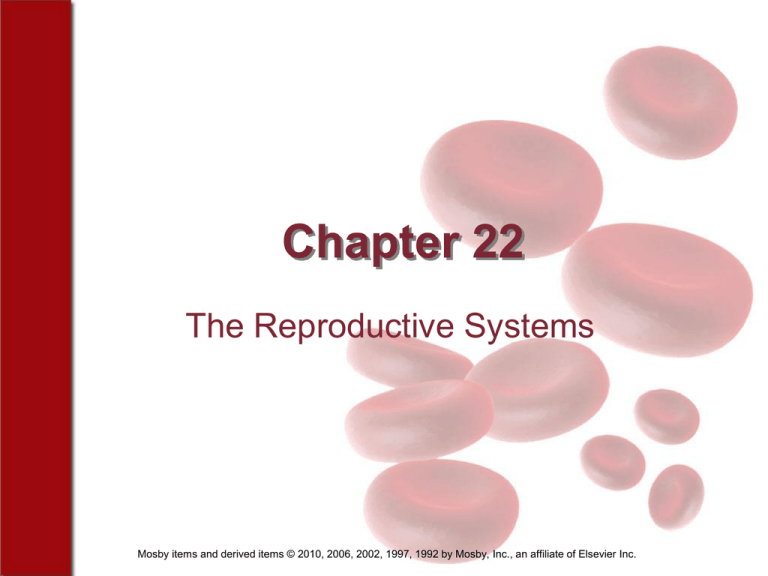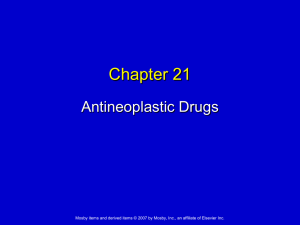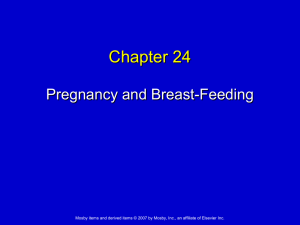
Chapter 22
The Reproductive Systems
Mosby items and derived items © 2010, 2006, 2002, 1997, 1992 by Mosby, Inc., an affiliate of Elsevier Inc.
Sexual Reproduction
• Gametes—sex cells that fuse at fertilization to
form a one-celled zygote.
– Sperm—gamete from the male parent
– Ovum—gamete from the female parent
2
Mosby items and derived items © 2010, 2006, 2002, 1997, 1992 by Mosby, Inc., an affiliate of Elsevier Inc.
3
Mosby items and derived items © 2010, 2006, 2002, 1997, 1992 by Mosby, Inc., an affiliate of Elsevier Inc.
Male Reproductive System
• Testes—gonads of men
• Testes in scrotum—lower temp
• Covered by tunica albuginea, which
divides testis into lobules
containing seminiferous tubules
• Interstitial cells produce
testosterone
4
Mosby items and derived items © 2010, 2006, 2002, 1997, 1992 by Mosby, Inc., an affiliate of Elsevier Inc.
5
Mosby items and derived items © 2010, 2006, 2002, 1997, 1992 by Mosby, Inc., an affiliate of Elsevier Inc.
6
Mosby items and derived items © 2010, 2006, 2002, 1997, 1992 by Mosby, Inc., an affiliate of Elsevier Inc.
Male Reproductive System
• Testes
– Functions
• Spermatogenesis is process of sperm production
– Meiosis forms four spermatids with 23
chromosomes
• Head contains genetic material
• Acrosome contains enzymes to assist sperm in
penetration of ovum
• Mitochondria provide energy for movement
7
Mosby items and derived items © 2010, 2006, 2002, 1997, 1992 by Mosby, Inc., an affiliate of Elsevier Inc.
8
Mosby items and derived items © 2010, 2006, 2002, 1997, 1992 by Mosby, Inc., an affiliate of Elsevier Inc.
9
Mosby items and derived items © 2010, 2006, 2002, 1997, 1992 by Mosby, Inc., an affiliate of Elsevier Inc.
Male Reproductive System
• Testes
• Production of testosterone by interstitial
cells
–Testosterone “masculinizes” and
promotes development of male
accessory organs
–Stimulates protein anabolism and
development of muscle strength
10
Mosby items and derived items © 2010, 2006, 2002, 1997, 1992 by Mosby, Inc., an affiliate of Elsevier Inc.
Male Reproductive System
• Reproductive ducts—sperm pass after
exiting testes until they leave the body
– Epididymis—coiled tube about 6 m in
length; lies along the top and behind the
testis in the scrotum
• Sperm mature and develop the capacity for
motility as they pass through the epididymis
• Epididymitis—painful inflammation
11
Mosby items and derived items © 2010, 2006, 2002, 1997, 1992 by Mosby, Inc., an affiliate of Elsevier Inc.
Male Reproductive System
• Reproductive ducts
– Ductus (vas) deferens—receives sperm
from the epididymis and transports them
from scrotum out of body
• Passes through inguinal canal
• Joins duct of seminal vesicle to form the
ejaculatory duct
12
Mosby items and derived items © 2010, 2006, 2002, 1997, 1992 by Mosby, Inc., an affiliate of Elsevier Inc.
13
Mosby items and derived items © 2010, 2006, 2002, 1997, 1992 by Mosby, Inc., an affiliate of Elsevier Inc.
Male Reproductive System
• Accessory sex glands
– Semen (seminal fluid): mixture of sperm and
secretions of accessory sex glands
• Averages 3 to 5 mL per ejaculation
• Each milliliter contains about 100 million sperm
– Seminal vesicles
• Produce about 60% of seminal fluid volume
• Secretion is yellowish, thick, and rich in fructose to
provide energy needed by sperm for motility
14
Mosby items and derived items © 2010, 2006, 2002, 1997, 1992 by Mosby, Inc., an affiliate of Elsevier Inc.
Male Reproductive System
– Prostate gland
•
•
•
•
Shaped like a doughnut and located below bladder
Urethra passes through the gland
Milk-colored secretion ~30% of seminal fluid volume
Activates sperm
Bulbourethral (Cowper) glands
• Resemble peas in size and shape
• Secrete mucus-like fluid (5% of seminal fluid volume)
that lubricates terminal portion of urethra
15
Mosby items and derived items © 2010, 2006, 2002, 1997, 1992 by Mosby, Inc., an affiliate of Elsevier Inc.
Male Reproductive System
• External genitals
– Penis and scrotum called genitalia
– Penis has three columns of erectile tissue
• Two dorsal columns called corpora cavernosa
• One ventral column surrounding urethra called
corpus spongiosum
– Glans penis—distal end of penis
• Covered by foreskin (prepuce)
• Surgical removal of foreskin called circumcision
16
Mosby items and derived items © 2010, 2006, 2002, 1997, 1992 by Mosby, Inc., an affiliate of Elsevier Inc.
17
Mosby items and derived items © 2010, 2006, 2002, 1997, 1992 by Mosby, Inc., an affiliate of Elsevier Inc.
Disorders of the
Male Reproductive System
• May cause infertility
• Disorders of the testes
– Oligospermia—low sperm production
– Cryptorchidism—undescended testes
– Testicular cancer—most common in young
adult men ages 25 to 35
18
Mosby items and derived items © 2010, 2006, 2002, 1997, 1992 by Mosby, Inc., an affiliate of Elsevier Inc.
Disorders of the
Male Reproductive System
• Disorders of the prostate
– Benign prostatic hypertrophy—enlargement
of prostate common in older men
– Prostate cancer is a leading cause of cancer
deaths in men over age 50
– Brachytherapy—small radioactive “seeds”
placed in prostate
19
Mosby items and derived items © 2010, 2006, 2002, 1997, 1992 by Mosby, Inc., an affiliate of Elsevier Inc.
20
Mosby items and derived items © 2010, 2006, 2002, 1997, 1992 by Mosby, Inc., an affiliate of Elsevier Inc.
21
Mosby items and derived items © 2010, 2006, 2002, 1997, 1992 by Mosby, Inc., an affiliate of Elsevier Inc.
Female Reproductive System
• Ovaries
•
•
•
•
Paired glands weighing about 3 g each
Resemble large almonds
Attached to pelvic cavity on each side of uterus
Microscopic structure
– Ovarian follicles— immature oocyte, 1 million at birth
– About 400,000 at puberty
– About 350 to 500 mature follicles ovulate during the
reproductive lifetime
22
Mosby items and derived items © 2010, 2006, 2002, 1997, 1992 by Mosby, Inc., an affiliate of Elsevier Inc.
23
Mosby items and derived items © 2010, 2006, 2002, 1997, 1992 by Mosby, Inc., an affiliate of Elsevier Inc.
Female Reproductive System
• Oogenesis—meiotic cell division produces
daughter cells with equal chromosome
numbers (23) but unequal cytoplasm
– Resulting ovum is large
– Polar bodies are small and degenerate
• Production of estrogen and progesterone
– Granulosa cells surrounding the oocyte in the mature
and growing follicles produce estrogen
– Corpus luteum produces progesterone
24
Mosby items and derived items © 2010, 2006, 2002, 1997, 1992 by Mosby, Inc., an affiliate of Elsevier Inc.
Female Reproductive System
• Production of estrogen and progesterone
– Estrogen causes development and maintenance of
secondary sex characteristics
– Progesterone stimulates secretory activity of uterine
epithelium and assists estrogen in initiating menses
25
Mosby items and derived items © 2010, 2006, 2002, 1997, 1992 by Mosby, Inc., an affiliate of Elsevier Inc.
Female Reproductive System
• Reproductive ducts
– Uterine (fallopian) tubes (or oviducts)
• Extend 10 cm from uterus into abdominal cavity
• Expanded distal end surrounded by fimbriae
26
Mosby items and derived items © 2010, 2006, 2002, 1997, 1992 by Mosby, Inc., an affiliate of Elsevier Inc.
Female Reproductive System
– Uterus
• Surgical removal called hysterectomy
– Removal may be abdominal, vaginal, or laparoscopic
– Total hysterectomy—removal of body and cervix of
uterus
– Subtotal hysterectomy—removal of body of uterus
only (cervix remains)
27
Mosby items and derived items © 2010, 2006, 2002, 1997, 1992 by Mosby, Inc., an affiliate of Elsevier Inc.
28
Mosby items and derived items © 2010, 2006, 2002, 1997, 1992 by Mosby, Inc., an affiliate of Elsevier Inc.
Uterine Wall
• Three layers
1. Perimetrium: serous layer (visceral
peritoneum)
2. Myometrium: interlacing layers of smooth
muscle
3. Endometrium: mucosal lining
Mosby items and derived items © 2010, 2006, 2002, 1997, 1992 by Mosby, Inc., an affiliate of Elsevier Inc.
30
Mosby items and derived items © 2010, 2006, 2002, 1997, 1992 by Mosby, Inc., an affiliate of Elsevier Inc.
• Endometriosis is an often painful disorder in
which tissue that normally lines the inside of
your uterus — the endometrium — grows
outside your uterus. Endometriosis most
commonly involves your ovaries, bowel or the
tissue lining your pelvis. Rarely, endometrial
tissue may spread beyond your pelvic region.
• http://vimeo.com/endometriosis/en
31
Mosby items and derived items © 2010, 2006, 2002, 1997, 1992 by Mosby, Inc., an affiliate of Elsevier Inc.
Female Reproductive System
– Vagina
• Distensible tube about 10 cm long
• Located between urinary bladder and rectum in
the pelvis
• Receives penis during intercourse and is birth
canal for delivery of baby
32
Mosby items and derived items © 2010, 2006, 2002, 1997, 1992 by Mosby, Inc., an affiliate of Elsevier Inc.
Female Reproductive System
– Breasts
• Size determined by fat quantity more than
amount of glandular (milk-secreting) tissue
• Lactiferous ducts drain at nipple, which is
surrounded by pigmented areola
• Lymphatic drainage leads to spread of cancer
cells to other body areas
33
Mosby items and derived items © 2010, 2006, 2002, 1997, 1992 by Mosby, Inc., an affiliate of Elsevier Inc.
34
Mosby items and derived items © 2010, 2006, 2002, 1997, 1992 by Mosby, Inc., an affiliate of Elsevier Inc.
Female Reproductive System
35
Mosby items and derived items © 2010, 2006, 2002, 1997, 1992 by Mosby, Inc., an affiliate of Elsevier Inc.
Female Reproductive System
– Phases
• Menses—about the first 4 or 5 days of the cycle;
varies somewhat
– Characterized by sloughing of bits of endometrium
(uterine lining) with bleeding
– First day of flow is day 1 of menstrual cycle
• Proliferative phase—days between the end of
menses and secretory phase; varies in length
– The shorter the cycle, the shorter the proliferative phase;
longer the cycle, longer the proliferative phase
– Characterized by repair of endometrium
36
Mosby items and derived items © 2010, 2006, 2002, 1997, 1992 by Mosby, Inc., an affiliate of Elsevier Inc.
Female Reproductive System
• Secretory phase—days between ovulation and
beginning of next menses
– Characterized by further thickening of endometrium
and secretion by its glands in preparation for
implantation of fertilized ovum
– Combined actions of the anterior pituitary hormones
FSH and LH cause ovulation
– Sudden sharp decrease in estrogens and
progesterone bring on menstruation if pregnancy
does not occur
37
Mosby items and derived items © 2010, 2006, 2002, 1997, 1992 by Mosby, Inc., an affiliate of Elsevier Inc.
38
Mosby items and derived items © 2010, 2006, 2002, 1997, 1992 by Mosby, Inc., an affiliate of Elsevier Inc.
39
Mosby items and derived items © 2010, 2006, 2002, 1997, 1992 by Mosby, Inc., an affiliate of Elsevier Inc.
40
Mosby items and derived items © 2010, 2006, 2002, 1997, 1992 by Mosby, Inc., an affiliate of Elsevier Inc.
Disorders of the Female
Reproductive System
• Tumors and related conditions
– Myoma, or fibroids—benign tumors of the
uterus
– Polycystic ovary syndrome (PCOS)—
enlarged ovaries with many fluid-filled
cysts
• Affects 10% of reproductive-age women
• Most common cause of female infertility
41
Mosby items and derived items © 2010, 2006, 2002, 1997, 1992 by Mosby, Inc., an affiliate of Elsevier Inc.
42
Mosby items and derived items © 2010, 2006, 2002, 1997, 1992 by Mosby, Inc., an affiliate of Elsevier Inc.
PCOS: Polycystic Ovary Syndrome
43
Mosby items and derived items © 2010, 2006, 2002, 1997, 1992 by Mosby, Inc., an affiliate of Elsevier Inc.
Disorders of the Female
Reproductive System
– Ovarian cysts—fluid-filled enlargements;
usually benign
• Follicular cysts—most common
• Luteal cysts—most symptomatic
• Most resolve in 60 days
– Endometriosis—presence of functioning
endometrial tissue outside the uterus
44
Mosby items and derived items © 2010, 2006, 2002, 1997, 1992 by Mosby, Inc., an affiliate of Elsevier Inc.
Disorders of the Female
Reproductive System
– Breast cancer is the most common type of
cancer in women
– Ovarian cancer can result from metastasis
of breast cancer or can arise independently
– Cervical cancer is often detected by a
Papanicolaou test (Pap smear)
– Infertility can result from factors such as
infection and inflammation, tumors, and
hormonal imbalances
45
Mosby items and derived items © 2010, 2006, 2002, 1997, 1992 by Mosby, Inc., an affiliate of Elsevier Inc.
46
Mosby items and derived items © 2010, 2006, 2002, 1997, 1992 by Mosby, Inc., an affiliate of Elsevier Inc.
Summary of Male and
Female Reproductive Systems
• Organs of reproductive system adapted for
specific sequence of functions that permit
development of sperm or ova followed by
successful fertilization and normal
development and birth of offspring
• Male organs produce, store, and ultimately
introduce mature sperm into female
reproductive tract
47
Mosby items and derived items © 2010, 2006, 2002, 1997, 1992 by Mosby, Inc., an affiliate of Elsevier Inc.
48
Mosby items and derived items © 2010, 2006, 2002, 1997, 1992 by Mosby, Inc., an affiliate of Elsevier Inc.
Hormonal Changes During
Pregnancy
• Human chorionic gonadotropin (hCG)
– Secreted by trophoblast cells, later chorion
– Prompts CL to continue secretion of
progesterone and estrogen
– hCG rise until end of second month, then
decline as placenta secrete progesterone
and estrogen
Mosby items and derived items © 2010, 2006, 2002, 1997, 1992 by Mosby, Inc., an affiliate of Elsevier Inc.
50
Mosby items and derived items © 2010, 2006, 2002, 1997, 1992 by Mosby, Inc., an affiliate of Elsevier Inc.
Estrogen
Oxytocin
(+)
from
placenta
from fetus
and mother’s
posterior pituitary
Induces oxytocin
receptors on uterus
Stimulates uterus
to contract
Stimulates
placenta to make
(+)
Prostaglandins
Stimulate more
vigorous contractions
of uterus
Mosby items and derived items © 2010, 2006, 2002, 1997, 1992 by Mosby, Inc., an affiliate of Elsevier Inc.
Figure 28.17
Summary of Male and
Female Reproductive Systems
• Female system produces ova, receives
the sperm, and permits fertilization
followed by fetal development and birth,
with lactation afterward
• Production of sex hormones is required
for development of secondary sex
characteristics and for normal
reproductive functions in both sexes
52
Mosby items and derived items © 2010, 2006, 2002, 1997, 1992 by Mosby, Inc., an affiliate of Elsevier Inc.







